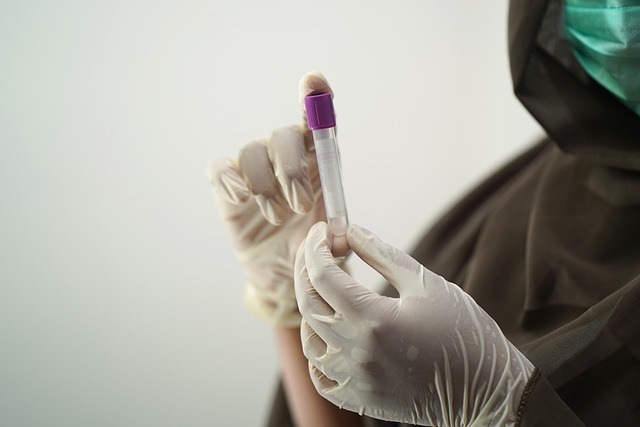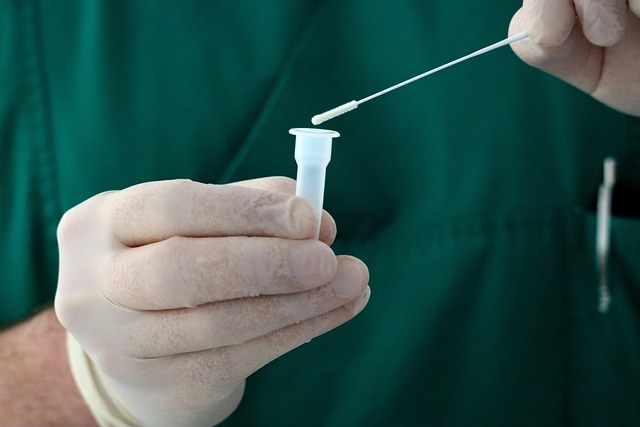The UK Ferritin Blood Test is an essential home-based diagnostic tool for assessing iron deficiency and anemia, a common condition characterized by symptoms like fatigue and paleness. This test measures ferritin levels, which indicate the body's iron stores, and can be used for ongoing health monitoring to track changes over time. It is as reliable as tests conducted in clinical settings and facilitates early detection and intervention, crucial for maintaining health and preventing complications. Available through reputable sources, the test kit includes all necessary components for a safe and straightforward blood sample collection process. Users must follow healthcare professional guidance to ensure accurate results and proper disposal of materials post-testing. Sharing the results with a healthcare provider is essential for professional interpretation and personalized health advice. Regular monitoring and periodic testing are key to managing iron levels effectively, highlighting the importance of the UK Ferritin Blood Test in maintaining overall health.
Maintaining health at home is increasingly a focus for individuals seeking convenience and personalised care. A pivotal aspect of this approach is recognizing conditions like iron deficiency, which can be accurately assessed through a UK Ferritin Blood Test. This article delves into the significance of such tests, offering a comprehensive guide to self-administering them and interpreting results for tailored health strategies. Embark on understanding how these tests can safeguard your well-being from the comfort of your home.
- Understanding Iron Deficiency and the Importance of UK Ferritin Blood Tests for Home Health Monitoring
- Step-by-Step Guide to Self-Administering a Ferritin Blood Test in the UK
- Interpreting Your Ferritin Blood Test Results and Next Steps for Personalized Health Care
Understanding Iron Deficiency and the Importance of UK Ferritin Blood Tests for Home Health Monitoring

Iron deficiency is a common condition that occurs when your body does not have enough stored iron to meet its needs, leading to anaemia. This deficiency can manifest through symptoms such as fatigue, pale skin, weakness, and shortness of breath. Understanding iron deficiency is crucial because it can affect people of all ages, with varying causes ranging from dietary insufficiencies to chronic diseases like haemochromatosis or inflammatory conditions. In the UK, the most reliable way to diagnose iron deficiency is through a blood test measuring ferritin levels, which reflects the body’s iron stores. The UK Ferritin Blood Test stands out as an essential tool for home health monitoring due to its simplicity and accuracy. It provides a quantitative assessment of iron reserves in the body, enabling individuals to track their iron status over time and assess whether dietary or lifestyle changes are effective. This test is particularly valuable because it can be performed by individuals at home, offering convenience and privacy while providing results that are comparable to those obtained in clinical settings. By identifying iron deficiency early, individuals can take proactive steps to address the issue through diet modification, supplementation, or medical intervention if necessary, thereby improving their overall health and well-being.
Step-by-Step Guide to Self-Administering a Ferritin Blood Test in the UK

In the UK, self-administering a ferritin blood test can be a straightforward process with the right guidance. Ferritin is a protein that stores iron in the body, and its levels can indicate whether you have too much or too little of this essential mineral. Iron deficiency or overload can lead to various health issues, so regular monitoring through a ferritin blood test is crucial for maintaining optimal health. To begin, it’s important to obtain a home blood testing kit from a reputable provider that complies with UK regulations. These kits include everything needed for the procedure: a lancet, sterile gauze, a test strip, a piercing device, and comprehensive instructions. Before proceeding, ensure you have received guidance from a healthcare professional on how to interpret results or consult the kit’s manual for step-by-step instructions.
Locate a site on your body where the skin is thin and rub the area with the alcohol swab provided to clean it. This is typically an area on the side of your fingertip or the back of your upper arm. Insert the lancet into the piercing device and select the depth that suits you best, usually 2-4 mm for a finger prick. Press the device against the prepared site and activate by tapping it as instructed. A small drop of blood will form; collect this on the test strip by touching the pipette end to the drop until it’s saturated. Then, place the test strip into the designated reader or follow the instructions for reading results if a reader is not included. Wait for any necessary time intervals as indicated before recording your ferritin levels. Once completed, apply gentle pressure to the site with the provided gauze to stop bleeding. Dispose of the lancet and all sharps responsibly according to local disposal guidelines. Afterward, it’s essential to report your results to a healthcare provider for professional evaluation and advice on how to proceed based on your ferritin levels. This home testing process enables individuals in the UK to monitor their iron storage levels conveniently and proactively manage their health.
Interpreting Your Ferritin Blood Test Results and Next Steps for Personalized Health Care

Understanding your ferritin levels through a blood test is crucial for maintaining iron homeostasis and overall health. In the UK, a Ferritin Blood Test can be conducted to measure the amount of ferritin—a protein that stores iron in the body—present in your bloodstream. Elevated ferritin levels may indicate excessive iron storage or inflammation, while low levels could suggest iron deficiency or chronic disease. Interpreting these results requires a nuanced understanding of various factors, including age, sex, and individual health conditions. It’s advisable to consult with healthcare professionals who can provide personalized guidance based on your specific ferritin levels and overall health profile.
Should your UK Ferritin Blood Test reveal abnormal levels, your healthcare provider will likely recommend a course of action tailored to your unique situation. This may involve dietary changes, iron supplements, or further investigation into underlying conditions contributing to these findings. Regular monitoring and follow-up tests are often necessary to track changes in ferritin levels over time. Personalized health care is key; adjustments to treatment plans will be made as needed, ensuring that you receive the most effective and safe interventions for your iron management needs.
Regular health checks at home play a pivotal role in maintaining one’s well-being, particularly when it comes to identifying conditions such as iron deficiency. The UK Ferritin Blood Test has emerged as an invaluable tool for early detection and management of this prevalent issue. With the guidance provided in understanding iron deficiency and the step-by-step instructions for self-administering a ferritin blood test, individuals can now approach their health with greater autonomy and precision. Interpreting these results empowers patients to engage proactively with their healthcare providers, leading to personalized treatment plans that optimize health outcomes. In conclusion, the convenience and accessibility of home health monitoring, including UK Ferritin Blood Tests, represent a significant advancement in self-care, enabling individuals to take charge of their health journey.
